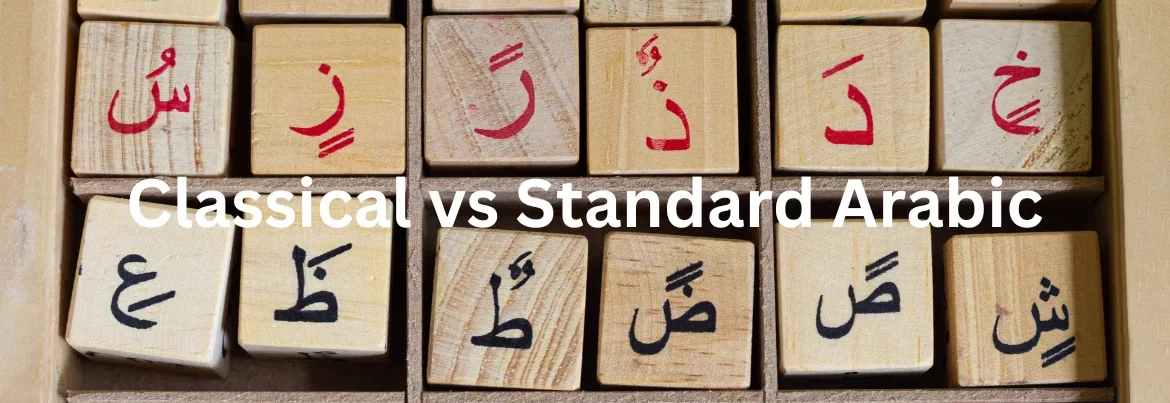
Classical Arabic vs. Modern Standard Arabic: 5 Differences
Arabic, one of the world’s most widely spoken languages, boasts a rich history spanning millennia. Its evolution has given rise to various forms and dialects, two of the most prominent being Classical Arabic and Modern Standard Arabic (MSA). Understanding the differences between these two linguistic variants is essential for anyone delving into the intricacies of the Arabic language. So, lets do a quick analysis between Classical Arabic vs Modern Standard Arabic.
-
Historical Context
Classical Arabic:
Classical Arabic, also known as Quranic Arabic, originated in the Arabian Peninsula during the 7th century CE. It serves as the language of the Quran, the holy book of Islam. Classical Arabic reached its pinnacle during the Islamic Golden Age and influenced literature, science, and governance across vast territories.
Our Classical Arabic language course helps you understand the Quran without translation. We focus on classical Arabic grammar, basic vocabulary, sentence structure, and practical conversations. Since around 70-80% of the Quranic text consists of recurring words, phrases, and themes, learning the basic vocabulary and sentence structure enables you to automatically understand a major portion of the Quran. The course is taught by native Arab tutors who can also speak fluent English, so there is no language barrier when explaining the concepts.
Modern Standard Arabic:
Modern Standard Arabic emerged as a standardized form of Arabic in the 19th and 20th centuries. It draws heavily from Classical Arabic but incorporates linguistic elements from various Arabic dialects. MSA serves as the lingua franca of the Arab world and facilitates communication across different Arabic-speaking countries.
-
Phonological and Phonemic Differences
Classical Arabic:
Classical Arabic pronunciation reflects the language’s historical roots and is often characterized by distinct phonemes not found in Modern Standard Arabic. It maintains archaic features such as the emphatic consonants (e.g., ض, ط, ص) and the pharyngeal sounds (e.g., ح, ع).
Modern Standard Arabic:
In contrast, Modern Standard Arabic exhibits simplified phonological features compared to Classical Arabic. While some dialectal influences are present, MSA generally lacks the intricate phonetic distinctions of its classical counterpart. Emphasis is placed on clarity and comprehensibility in communication.
-
Lexical and Morphological Variances
Classical Arabic:
Classical Arabic boasts a vast lexicon, enriched by centuries of literary and scholarly contributions. It features archaic vocabulary and intricate grammatical structures, reflecting the linguistic norms of the time. Classical Arabic texts are renowned for their eloquence and poetic beauty.
Modern Standard Arabic:
Modern Standard Arabic retains much of the lexicon and morphology of Classical Arabic but incorporates modern terms and expressions to accommodate contemporary needs. It tends to simplify complex grammatical constructs, making it more accessible for communication in diverse contexts.
-
Sociolinguistic Usage
Classical Arabic:
Classical Arabic primarily serves as the language of religion, academia, and classical literature. It is revered for its cultural significance and is commonly used in formal religious ceremonies, scholarly discourse, and traditional poetry.
Modern Standard Arabic:
Modern Standard Arabic fulfills a broader communicative function, serving as the primary medium for written communication, formal speeches, media broadcasts, and educational materials across the Arab world. It bridges the gap between diverse Arabic dialects, enabling mutual understanding and cohesion.
-
Evolution and Adaptation
Classical Arabic:
Classical Arabic remains preserved in its original form within religious texts and classical literature. While it has undergone minor linguistic changes over the centuries, its core structure and grammar have remained relatively consistent, serving as a testament to the enduring legacy of the Arabic language.
Modern Standard Arabic:
Modern Standard Arabic continues to evolve in response to contemporary linguistic trends and global influences. As societies modernize and new technologies emerge, MSA adapts to accommodate these changes while preserving the linguistic heritage of the Arab world.
Parting Thoughts
Classical Arabic vs Modern Standard Arabic represent distinct yet interconnected facets of the Arabic language. While Classical Arabic serves as a testament to the language’s rich heritage and religious significance, Modern Standard Arabic embodies the dynamic evolution and adaptability of Arabic in the modern era. Understanding the differences between these two forms is crucial for appreciating the diversity and complexity of Arabic linguistic traditions.